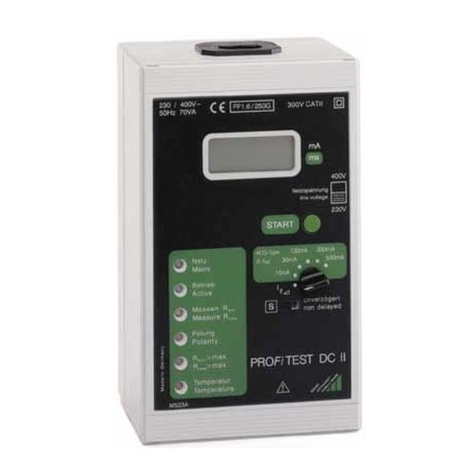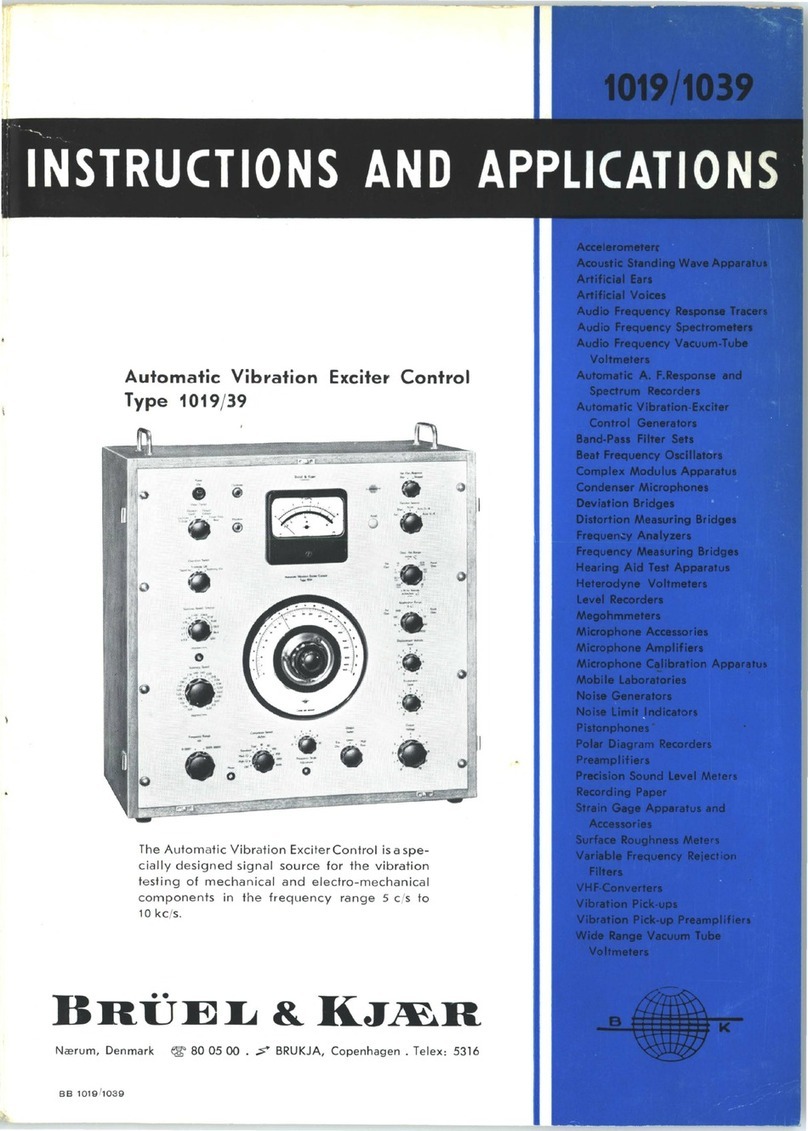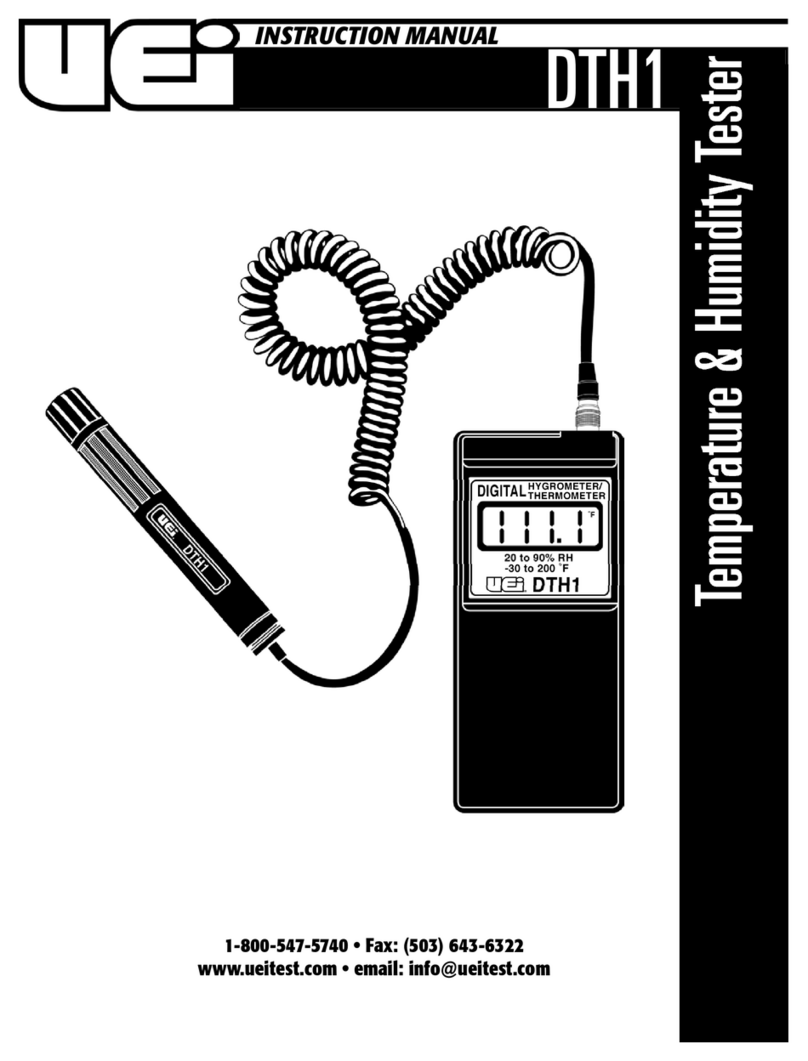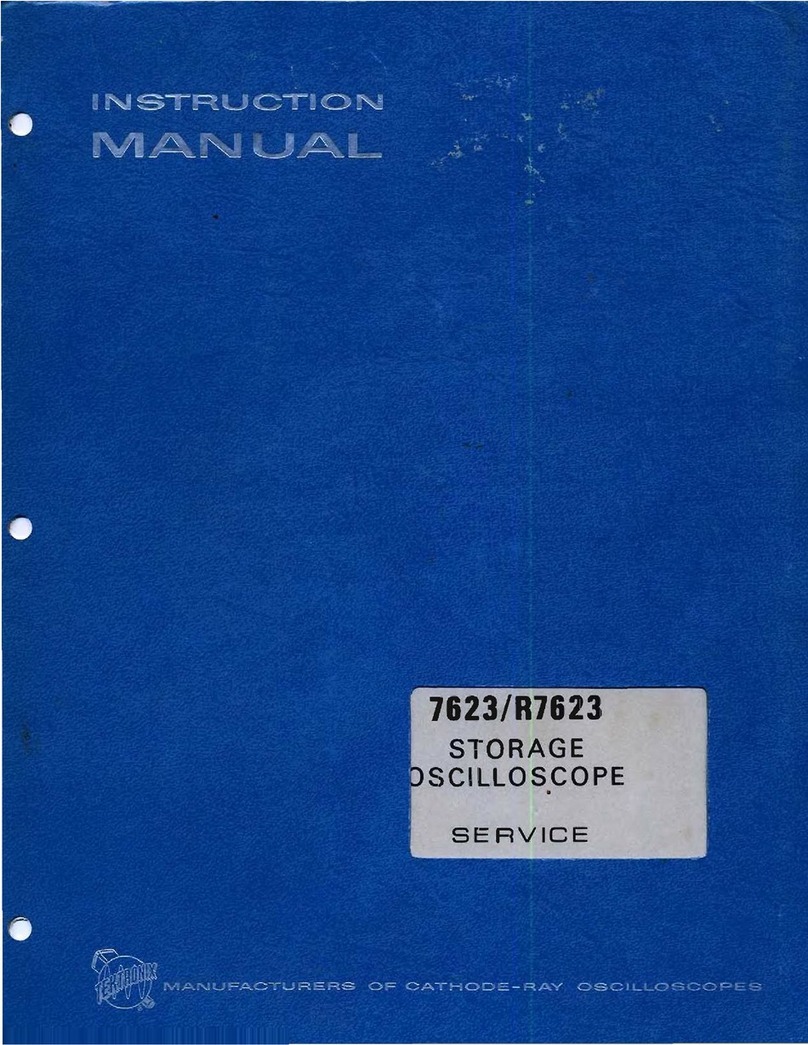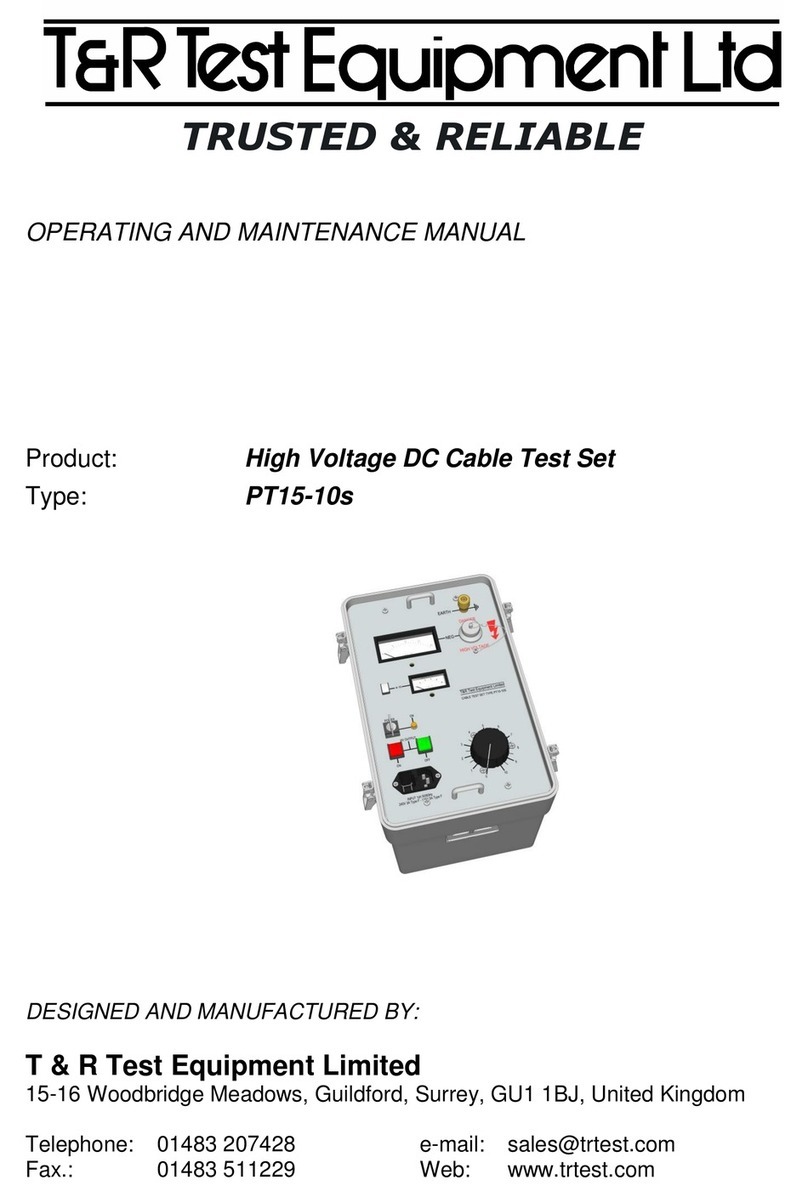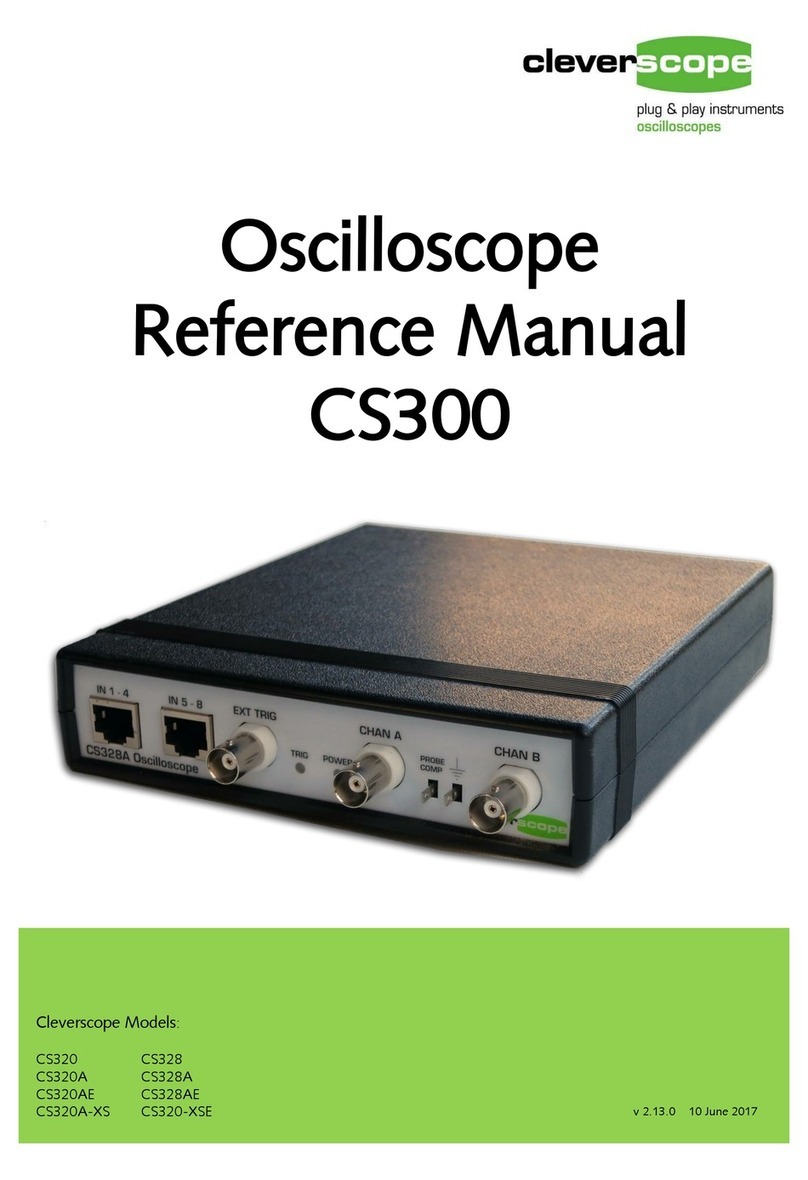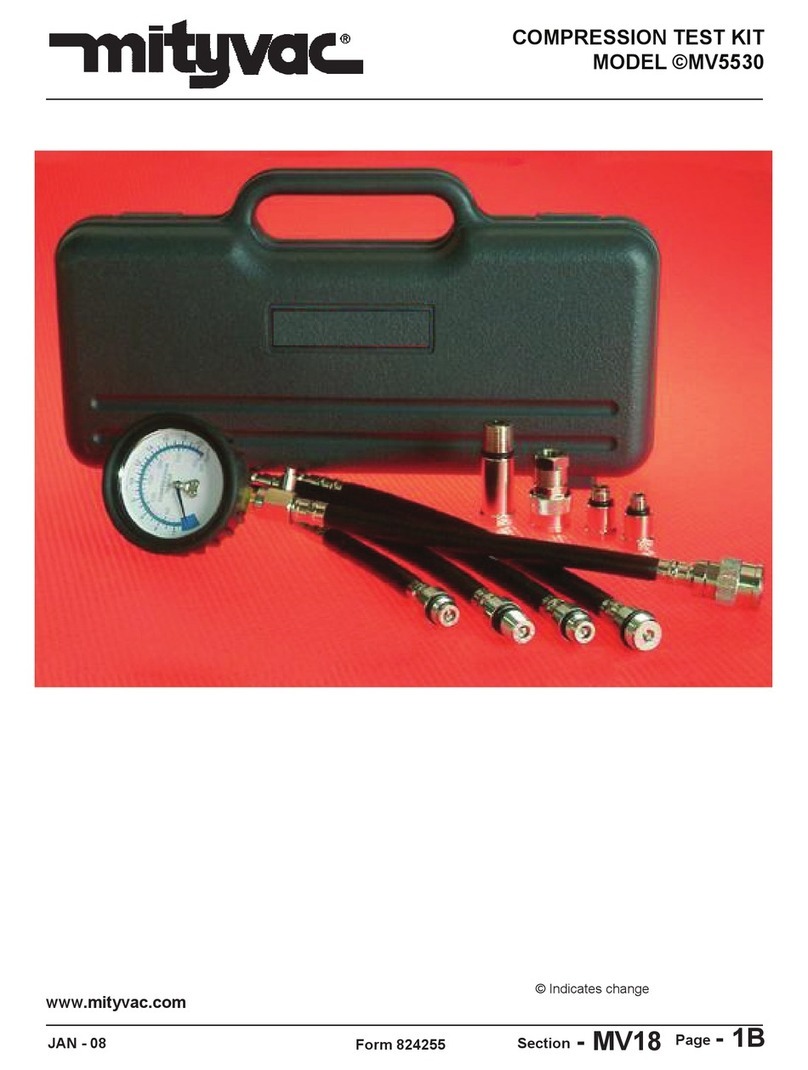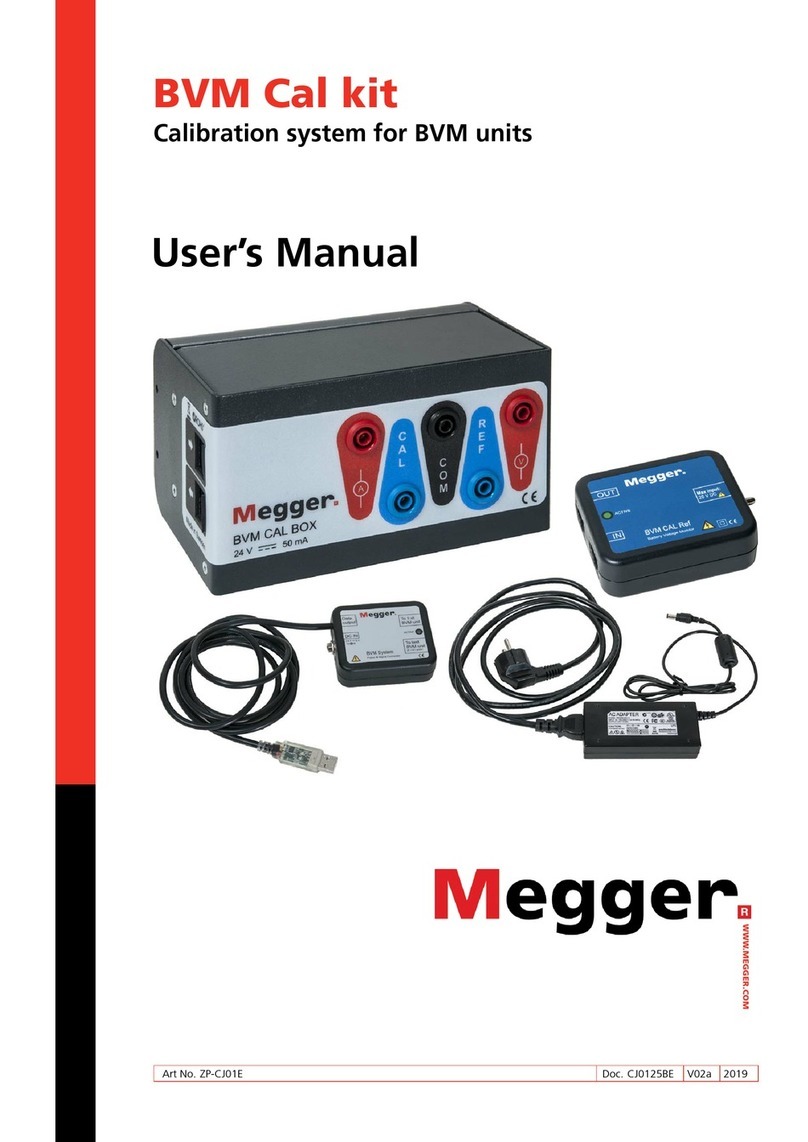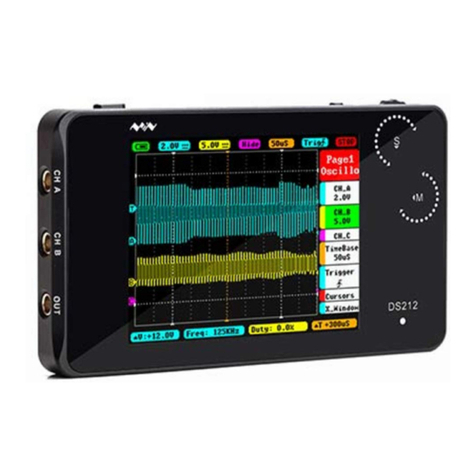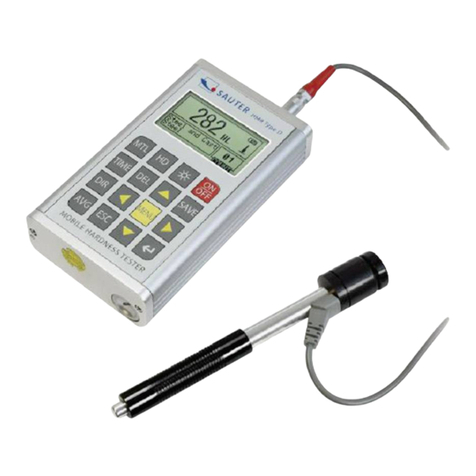Stereo Optical Optec 5000G INT User manual

Reference and Instruction Manual
Optec® 5000GINT
Vision Tester
P/N 56264
C
-
STEREO OPTICAL
©Stereo Optical Co., Inc. 06/2020. All rights reserved

Introduction
Good vision is a precious gift, which should be guarded, cherished, and nurtured throughout life. To
maintain good vision, frequent vision screenings and periodic visual exams are necessary. In this
way, an awareness of inadequate vision or changes in vision can be noted. The eye care
professional can then correct most visual problems. Without these screenings, many children and
adults would have undetected visual difficulties, having a direct effect on their quality of life.
Eye care professionals feel that the earlier vision screening can begin, the more rewarding the
results can be. This attention should be continued throughout adult life, with specific attention to the
working years.
The Stereo Optical Optec 5000GINT Vision Tester does this screening efficiently. It is a precision
instrument designed to do quick, accurate, reliable, and confidential screening. It will identify those
who have a problem and need professional assistance.
1

External Features
The serial number is located on the inside of the Slide Access Door
2
Forehead Activator: Controls illumination inside the Vision Tester. It will only activate the lights when the subject
maintains pressure against the activator, insuring the subject to be at a proper distance for testing. When forehead
pressure is applied to the bar, the green "Ready" indicator will be illuminated on the control panel and the subject will be
ready to be tested.
Headrest Tissue: The tissue cushions the subject's forehead while allowing maximum hygienic conditions.
Lens System: The upper lenses are for FAR Point testing (simulated distance of 20 ft.) The subject looks straight
ahead. The lower lenses are for NEAR Point testing (simulated distance of 16 in.) with the subject looking down while
holding his/her head straight. The lenses are easily accessible for cleaning and the faceplate is wide enough to
accommodate wide contemporary eyeglass frames.
Instrument Base: It gives a stable foundation for the vision tester in all positions.
Elevation Adjustment: Simply depress the button in the base and adjust the instrument to the desired height for each
subject. Release button and the instrument are locked in place.
Observation Doors: Located on both sides of the instrument, allow the tester easy access to both FAR and NEAR test
slides. A pointer can be used by the tester to assist the subject in identifying the targets. The pointer is held in place by
clips inside the door. The doors are held closed with magnets.
FAR and NEAR Indicators: Located on both sides of the instrument, these lights indicate how the instrument is set to
test accordingly.
Test Dial and Knob: Located on both sides of the instrument, is used to change slides in the viewing area. The
numbers on the dial correspond to the numbers on the record form for identifying the test slide. The number under the lit
indicator is the number of the test in the viewing area.
Electronic Control Panel: Operates the functions of the vision tester, power switch, right and left eye switches, Near
and Far switches, Day and Night switches, glare switch, and the peripheral test controls.
Instrument Body: The Instrument Body is lightweight and is made of flame retardant ABS plastic.
Carrying Handle: Built-in for maximum convenience. The rigid handle and lightweight body aid in ease of portability.
Ancillary Lens Holder

1. Forehead Activator
2. Headrest Tissue Holder
3. Lens System
4. Instrument Base
5. Elevation Adjustment
6. Observation Door
7. Far and Near Indicators
8. Test Dial and Knob
9. Receptacle For Power Cord and Control Panel
10. Instrument Body
11. Carrying Handle
12. Ancillary Lens Holder
12
3
4
5
6
7
8
9
(see pg 4
image)
10
3
1112

4
1
Internal Features
An advanced Day and Night lighting system renders a white homogenous light, resulting in high
contrast images and truer color reproduction.
The microprocessor controlled homogenous illumination system assures accurate and repeatable
testing results.
Front surface mirror offers a ghost-free image for more accurate testing of distance vision. The
Optec 5000G INT Vision Tester also includes glare system for use in both day and night testing
conditions.
Up to 12 test slides can be mounted on a rotatable drum. The slides can easily be removed or
replaced in seconds.
Stereo Optical's slides are manufactured from a high-resolution photographic film mounted
between two layers of glass. The high resolution of (500/line pairs/mm) affords a much finer acuity
level for more accurate testing.
Stereo Optical's slides are trans illuminated to eliminate glare and reflection. The result is a more
accurate image, therefore a more accurate test.

Advanced Design Control Panel
The control panel is designed for convenience in both operation and maintenance.
Right Eye:
When the forehead activator is depressed, the right eye will see the test target. When the switch is
turned OFF, the right eye will see nothing. To turn switch ON, depress; to turn OFF, press again.
Left Eye:
When the forehead activator is depressed, the left eye will see the test target. When the switch is
turned OFF, the left eye will see nothing. To turn switch ON, depress; to turn switch OFF, press
again.
Binocular:
When both the left eye and right eye are activated, a binocular test is being performed.
Far/Near Switch:
When the switch is on, the unit is set for FAR point testing. The testing distance simulated in the
instrument is 20 feet. Cycle the test appropriately to achieve the test you desire according to the
Near and Far indicators.
Power Switch:
Master On/Off power, (located on the back of the instrument) depress ON, press again for OFF.
Ready Light:
Green light indicates that the subject is pressing against headrest activator and is at proper testing
distance.
Perimeter Switches:
Optec 5000G INT Vision tester with perimeter.
The perimeter function is to test the lateral(horizontal) visual field.
Four switches pertain to peripheral vision testing. All are momentary switches; they stay on only if
pressure is applied.
45 nasal
55 temporal
70 temporal
85 temporal
The same switches are used for testing both sides, right and left. Depress the eye selector for the
eye that is to be tested.
5

Glare Settings
Before the Optec 5000G INT vision tester is turned on it is important that the dial is set at
#1 and that the #1 on the dial is located at the FAR point indicator.
When Optec 5000G INT is turned on the instrument defaults to the NO GLARE setting
also. You can activate the glare function for distance tests by pressing the GLARE button.
6

Glare Function with Optec 5000G INT
The Optec 5000G INT vision tester was created to satisfy a growing concern among
occupational health professionals – glare.
It is difficult to perform job functions and everyday functions when there are varying intensities of
light entering the eye. Often, a bit of time is needed for your eyes to become acclimated with the
luminance and glare within a particular environment. This can be true with driving a car or
performing a specific job task. Optec 5000G INT will help you to assess the time needed to
adjust and help to quantify your corresponding vision.
One simply needs to administer the acuity test with Optec 5000G INT with the glare function on
to gauge a patient’s acuity with this high-intensity radial glare source. This can be administered
in one of two ways:
1. Have the patient place his head against the forehead actuator to administer the acuity test.
Press the “GLARE” button to activate the radial glare source. Administer the acuity test as
you would normally.
2. Have the patient place his head against the forehead actuator to administer the acuity test
after pressing the “GLARE” button to activate the radial glare source. Turn off the glare after
a predetermined amount of time and then immediately time how long it takes your patient to
identify a specific line of acuity.
The information obtained will allow you to identify candidates with the requisite vision for their
particular job function or determine if a patient does not meet the vision portion of the job
standards laid forth by the entity for which the screening is performed and their consultant
eye care professional.
7

Vision Testing--The Right Way
Look into the instrument and note what happens when the eye switches are ON and OFF.
Experiment with viewing FAR point slides at NEAR point and vice versa, by dialing through all 12
slides. First, view all slides in the FAR point mode, and then repeat in the NEAR mode. Note that
FAR test slides viewed at NEAR are upside-down, as are the NEAR test slides viewed at FAR. It is
important to recognize whatever the subject may be describing and be able to answer any questions.
Concentrate on acquiring a smooth delivery of instruction and description of the test target, as well
as confidence in handling the instrument. The tester's administrative expertise can help relax the
subject, achieve cooperation, and a more accurate response.
When speaking to the subject, never act surprised or provoked by their response or lack of
response. Give the subject every opportunity to demonstrate his/her best vision.
If the subject normally wears glasses or contact lenses, he/she should wear them during the testing
to determine whether or not his/her prescription is still adequate.
Select a table or counter of convenient height with sufficient surface space for the instrument and the
recording of these results. Normal room lighting is acceptable, but care should be taken to avoid light
shining on the lenses or on the subject's face.
IMPORTANT CHECKPOINTS:
- Be certain the instrument is plugged into a 110 to120 VAC or a 240 V to DC power + 24 V outlet.
- Adjust instrument to proper height for subject's comfort by depressing button on base and moving
the housing.
-Before the instrument is turned on, the dial must be rotated so that the number '1' is located
under the FAR indicator. This must be done each time the unit is turned on.
- Push power switch on back of instrument to activate the instrument.
-Tear off headrest tissue, so a clean tissue is ready for the subject.
- Be certain the subject presses their forehead against the headrest activator so the illumination in
the unit is activated and the GREEN "READY" indicator on the control panel is lit.
- Be certain the subject is comfortable.
- Be certain to have a clean record form and a scoring marker.
You are now ready to test
8

Optec 5000G INT Peripheral Test
This is a test of peripheral vision on the horizontal plane. The lights flash at 85, 70, and 55
degrees temporally and approximately 45 degrees nasally, so a possible total of 130 degrees
arc can be attained. (Highest temporal reading plus nasal reading).
Caution should be taken because the temples of eyeglass frames could interfere with this
test. The test should be taken with eyeglasses on and again with the glasses off to determine
if the frame interferes with peripheral vision.
To Administer The Test:
1. FAR Switch ON
2. RIGHT Eye switch ON
3. LEFT Eye switch OFF
4. Dial #1at Yellow Indicator
Subject should look straight ahead, through the FAR lens system, with his/her forehead against
the headrest activator. Ask the subject to look at slide #1. Then ask the test subject to point his
finger in the direction he sees the light. The test administrator will then press one of the four
switches, nasal, 55, 70 or 85 degrees on the control panel. The switches can be pressed in any
order and should be held down for two or three seconds. Repeat the test with the left eye by
turning the RIGHT illuminated switch off and turning the Left illuminated switch on.
NOTE: This test can be administered to a one-eyed person. In this case, the nasal test
becomes very important because it will determine if there is peripheral vision on the blind side.
9

Maintenance of your Optec 5000G INT
The Optec 5000G INT Vision Tester is designed to minimize maintenance. All bearings and
internal mechanisms have been sealed at the factory. It has been engineered and built for a
lifetime of use. The only annual maintenance required is simple and does not necessitate a
service call. The only components requiring occasional maintenance are:
Eyepiece Lenses: The external side of these lenses needs to be cleaned occasionally. Care
should be taken not to use any abrasive material on these lenses. Use the cleaner supplied with
the Vision Tester, or plain soap and water can be substituted. It is important to dry the lenses
with a soft, lint-free cloth.
Cleaning of Slides: Open the rear door. Use a damp, soft, lint free cloth with lens cleaner and
wipe the slide. Turn the dial and go on to the next slide repeating the same procedure. Note:
Always unplug the tester before opening the back door and accessing the slides.
Replacement of the Slides: The slide drum assembly holds up to 12 slides and can be easily
accessed through the rear door. To replace a slide, rotate the dial until the number of the slide to
be removed is under the YELLOW indicator. Open rear door, remove slide on top of drum by
rotating clips toward each other until they clear the slide. Remove unwanted slide. Insert new
with label showing and arrow pointing away from you; return spring clips to their former positions
to secure slide. Close the instrument door and you are again ready for operation.
Control Panel Removal: The panel is designed with reliable solid state components. The
modular design allows quick segmentation from the rest of the instrument.
Exterior: The plastic, of which the instrument body and base are made, is similar to your
telephone and can be cleaned in the same manner. Use damp, clean cloth and a mild detergent.
A dust cover is provided for dust protection and to discourage tampering when instrument is not
in use. An eight-foot power cord can be disconnected to discourage tampering as well.
Inside Mirror: Behind the rear door you will find a front-surface mirror. Handle the mirror with
care and avoid placing fingers on its surface. We recommend using the cleaner supplied with the
instrument along with a damp, soft, lint-free cloth. DO NOT TAMPER WITH THE THREE
SCREWS SURROUNDING THE MIRROR. The mirror has been carefully aligned to achieve
precise light reflections and any tampering will require factory adjustment.
10

Accessories and Supplies Available
Lens#1 39.25 in. 100 centimeters
Lens #2 31.48 in. 80 centimeters
Lens #3 26.23 in. 66.7 centimeters
Lens #4 22.49 in. 57.1 centimeters
Lens #5 19.68 in. 50 centimeters
Carrying Case: Soft-sided or soft-sided with wheels
11
Accessories and Supplies Available
Test Slides: Black and White
Color Special
Headrest Tissue: 50 sheets per pad 100 per
package
Dust Cover
Pointer
Power Cord & Power Supply
Lens Cleaner: 2 oz bottle
Plus Lenses: Plus 1.75D Plus 2.25D
Intermediate Lenses: Set of 5

Accessory Kit
(Supplied with the instrument)
Reference and Instruction Manual .......................................................1 (including slide descriptons
Scoring Pad .......................................................................................................1 pad of 50 sheets
Headrest Tissue .............................................................................................10 pads of 50 sheets
Dust Cover .........................................................................................................1
Pointer ................................................................................................................1
Lens Cleaner ..................................................................................................... 1 bottle (2 oz.)
Power Cord ........................................................................................................1
Power Supply......................................................................................................1
12

Glossary
Accommodation:
The ability of the eye to refocus from one distance to another.
Acuity:
Clearness or sharpness of images.
Amblyopia:
Also referred to as lazy eye, loss of sight in one eye.
Astigmatism:
A mis-shaping of the eye that prevents light rays from coming to a single focus on the back of
the eye.
Binocular:
Ability to use two eyes simultaneously to focus on the same object and to fuse two images into a
single image.
Candela:
The standard unit of luminous intensity. Illumination of target slide represent in cd/m²
Cataract:
Opacity of the crystalline lens.
Color Deficiency:
Diminished ability to perceive differences in certain colors.
Contact Lens:
The thin shell of plastic which rests directly on the tear film of the cornea and corrects refractive
error.
Convergence:
Turing the two eyes inward to see a nearby object.
Cornea:
The clear transparent covering on the front of the eye.
Dark Adaptation:
The process by which an eye adjusts to decreased illumination and becomes more sensitive to
light.
Depth Perception:
The ability to judge distance of objects from each other or from the observer.
Diopter:
A measurement of optical power or lenses.
Diplopia:
Double vision.
13

Divergence:
The process of directing two eyes from a near point to a far point.
Esophoria:
The tendency of the eye to pull inward on the horizontal plane.
Exophoria:
The tendency of the eye to pull outward on the horizontal plane.
Far Point:
Twenty feet to infinity.
Fixation:
Directing the eye so the image centers on the fovea.
Focus:
The point at which light rays will come together after passing through a lens.
Fusion:
Powere of coordination by which images received by two eyes become a single image.
Hyperopia:
Farsightedness, the images focus behind the retina.
Hyperphoria:
When either eye has a tendency to pull up on the vertical plane.
Intermediate Vision:
Vision which focuses at some point beyond 18 inches or 45 centimeters (Near Point) and less
than 20 feet or 6 meters (Far Point).
LUX:
The unit for measuring of glare.
Malingerer:
A person who pretends to have a vision problem.
Mesopic:
Pertaining to illumination between the photopic and scotopic ranges.
Monocular:
Seeing with only one eye.
Muscle Balance:
The coordination of muscles allowing two eyes to work together on the vertical and lateral
planes.
Myopia:
Nearsightedness; has problem seeing at a distance; images focus in front of the retina.
14

Near Point:
14 to 16 inches or 35 to 40 centimeters.
Occlusion:
Obscuring the vision of an eye.
Peripheral Vision:
Ability to perceive the presence, motion, or color of objects outside the direct line of vision.
Phoria:
Root word denoting a latent deviation in which the eyes have a constant tendency to turn from
the normal position for binocular vision.
Photoptic:
Vision under bright lighting levels.
Potential Acuity:
A quick assessment of macular function in cataract patients and documents that surgery is
expected to improve visual performance.
Presbyopia:
Loss of accommodation so it is difficult to focus on near objects.
Refraction:
The bending of the rays of light. Sometimes used to refer to an examination for glasses or
contact lenses.
Scotopic:
Vision at low light levels.
Stereopsis:
The ability to perceive depth.
Strabismus:
A muscle imbalance. Eyes turn inward or outward.
Suppression:
The non-use of vision in one eye.
Vision:
The ability to see and to interpret what is seen.
Visual acuity:
Vision of an eye or eyes.
15

Safety Aspects
Use this device properly and safely.
BEFORE USE OR MAINTENANCE, READ THIS MANUAL.
This operator's manual contains information necessary for the operation of the Optec 5000G INT
Vision Tester. This manual includes operating procedures, safety precautions, and
specifications. IEC standards are applied in this manual.
Safety Precautions
In this manual, a signal word is used to designate the degree or level of safety alerting. The
definitions are as follows.
CAUTION indicates a potentially hazardous situation which, if not avoided, may result in injury or
property damage.
Even situations indicated by “CAUTION” may result in serious injury under certain conditions.
Safety precautions must be strictly followed at all times.
Handling Precautions
Before use of instrument
CAUTION
- Do not use the device for other than its intended purpose.
STEREO OPTICAL will assume no responsibility for accident or malfunction caused by improper
use.
- Never modify or touch the internal structure of the device. Electric shock or malfunction may
result. There are no user-serviceable parts inside the device.
-Verify that the following specified environmental conditions for installation are met. In addition,
verify that usage area meets the following conditions.
16

Make certain that the instrument is operated in the following environment conditions:
Humidity 30% to 75%
No large amount of dust is contained in the air
Subdued ambient light
Locate instrument in a place free from vibration or impact
Locate instrument on a stable surface
· Be sure that a power outlet meets the power requirements.
If the supplied voltage is too high or low, the device may not deliver full performance and malfunc-
tion, or fire may result.
· Be sure to use the power supply that came with the device. Using any adapter other than the sup-
plied one may result in malfunction, or may void the warranty.
· Do not use an extension cord when supplying the device with the power.
· Be sure to connect using a grounded outlet. Electrical shock or fire may result in event of malfunc-
tion or electrical leakage.
· Never crush or pinch the power cord with heavy objects. Damage may result in electrical shock or
fire.
· Before connecting cables to the device turn the instrument OFF and disconnect the power cord of
the power supply from the power outlet.
Usage Precautions
CAUTION
The device has been tested and found to comply with the limits for the medical devices to the IEC
60601-1-2 and EN55011. These limits are designed to provide reasonable protection against harmful
interference in a typical medical installation. This device generates, uses and can radiate radio fre-
quency energy. If not installed and used in accordance with the instructions, may cause harmful
interference to other devices in the vicinity. However, there is no guarantee that the interference to
other devices, which can be determined by turning the device off and on, is caused by this instru-
ment. The user is encouraged to try to correct the interference by one or more of the following
measures :
- Reorient or relocate the receiving device.
- Increase the separation between the device.
17

- Connect the device into an outlet on a circuit different from that which was previously used.
-Consult STEREO OPTICAL for help.
- Connect the cable to the interface connector securely, maintaining the correct orientation of
the connector of the cable.
Proper data communication with an external computer will not perform if the internal wires of the
power cord are exposed, power to the device is interrupted by moving the cord, or the plug or cord
becomes extremely hot, this indicates that the cord is damaged. Immediately replace the power
cord.
In case of malfunction, immediately unplug from the power outlet and contact your authorized dis-
tributor for replacement; otherwise, electric shock or fire may result.
- In the event that a strange odor or smoke is noticed coming from the device, turn it off and
unplug the power cord immediately. After confirming that the odor or smoke is no longer being
produced, contact you authorized distributor. Continued use may result in electric shock or fire.
18

Maintenance
CAUTION
·Only service technicians trained properly by STEREO OPTICAL may service the device.
STEREO OPTICAL assumes no responsibility for accidents resulting from improper servicing.
·There are no user-serviceable parts inside the device.
·All returns must have a Return Material Authorization number
Disposal
·Follow local governing ordinances and recycling plans regarding disposal or recycling of device
components. It is recommended to commission the disposal to a designated industrial waste dis-
posal contractor.
·When disposing of packing materials, sort them by material and follow local governing ordinances
and recycling plans
Before use : Device Description
Power Supply
Special adapter that converts the AC power to 110V to 220V or 240 V to DC power + 24V
Labels and indications on the device
Warning labels and indications are affixed on the device. If the labels are removed, contact STEREO
OPTICAL or your authorized distributor. Sample below:
19
Table of contents
Popular Test Equipment manuals by other brands
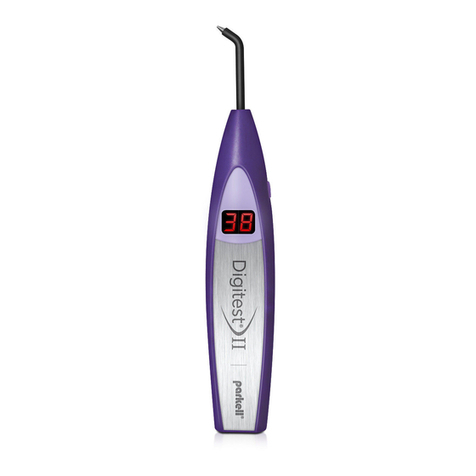
parkell
parkell Digitest II Instructions for use
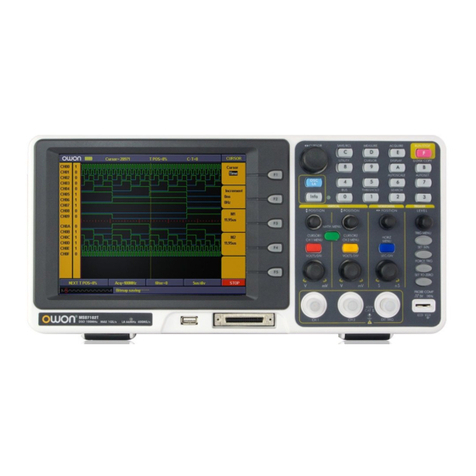
Owon
Owon MSO7102T user manual

Tektronix
Tektronix 71310 instruction manual

Norsonic
Norsonic nor1256 instruction manual
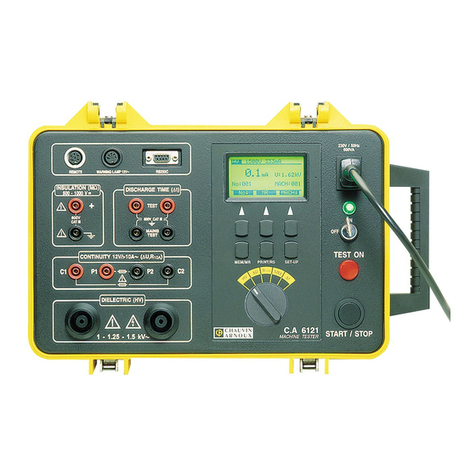
Chauvin Arnoux
Chauvin Arnoux C.A 6121 user manual
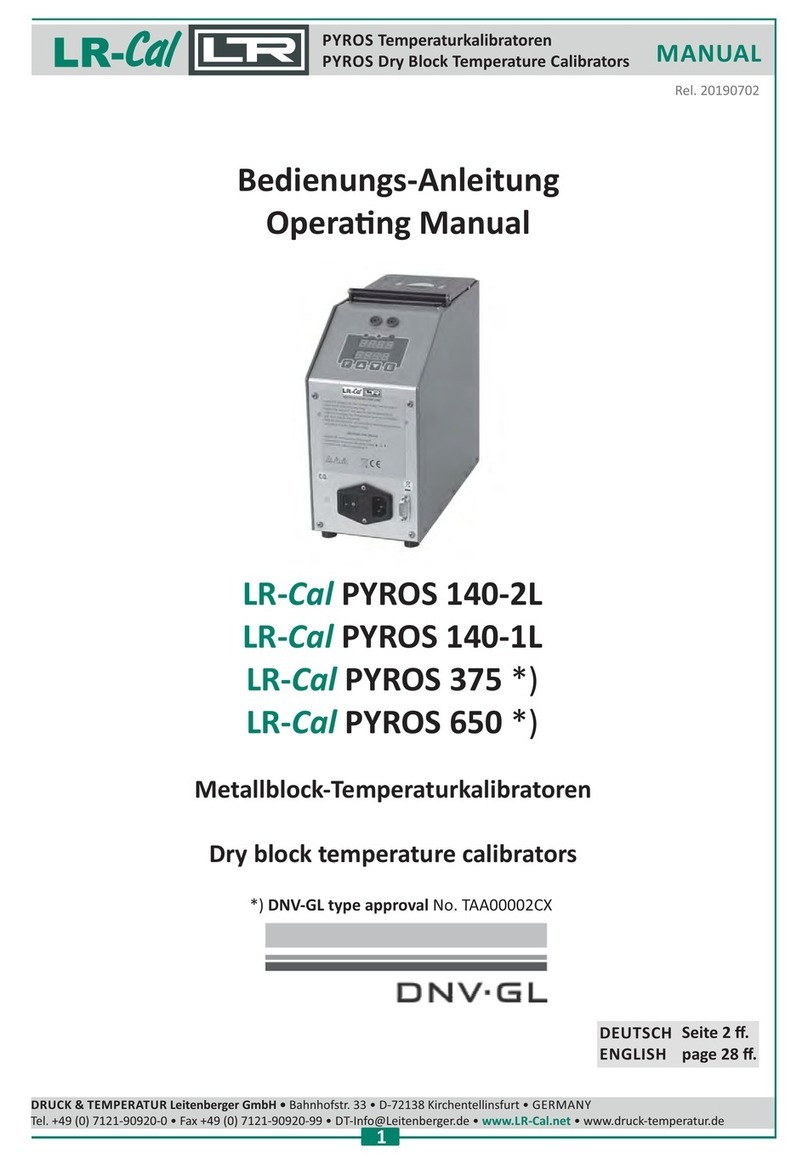
DRUCK & TEMPERATUR Leitenberger
DRUCK & TEMPERATUR Leitenberger LR-Cal PYROS Series operating manual

